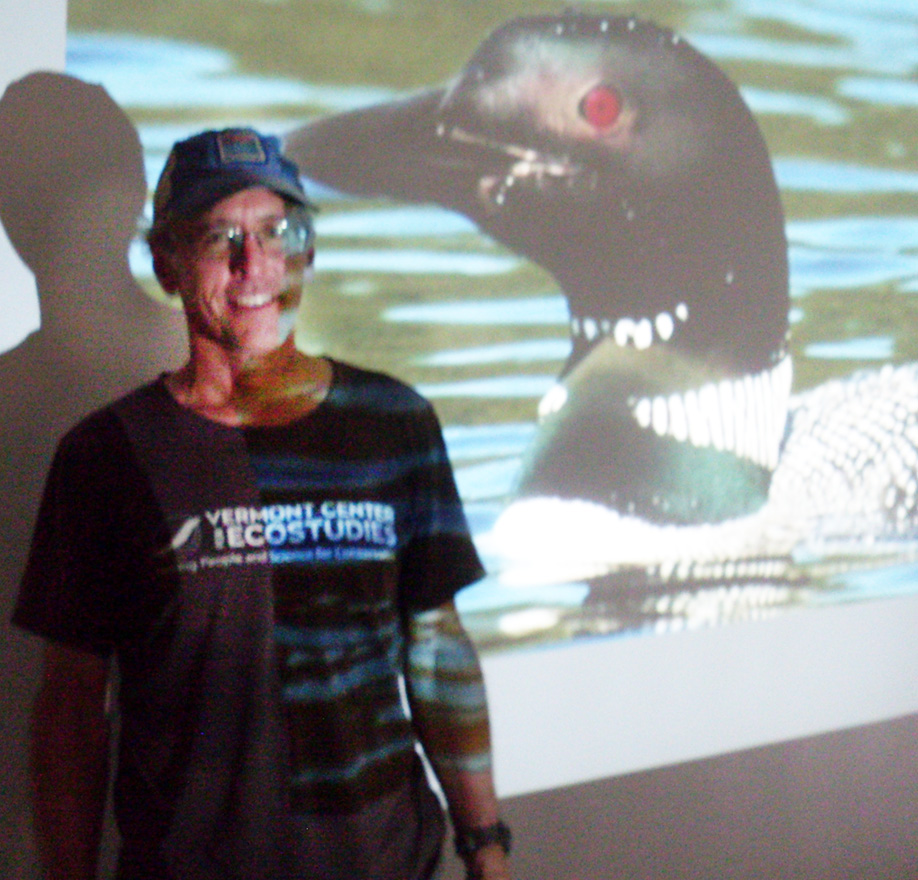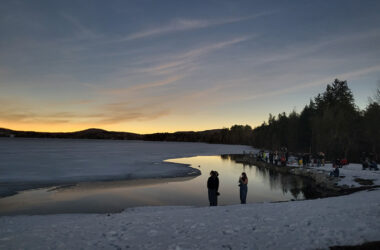
photo by Hal Gray
Eric Hanson, biologist who coordinates the Vermont Loon Conservation Project for the nonprofit Vermont Center for Ecostudies, made a presentation on the common loon at the Greensboro Free Library on July 26.
by Hal Gray
GREENSBORO – Eric Hanson’s illustrated presentation on loons drew a big crowd on July 26, at the Greensboro Free Library.
Hanson is the biologist who coordinates the Vermont Loon Conservation Project (VLCP) for the nonprofit Vermont Center for Ecostudies (VCE) which partners with the Vermont Fish and Wildlife Department. He reported seeing 15 loons on Caspian Lake this summer, including two chicks. These chicks will fly in November, in eight or nine weeks when their wings are ready, to the ocean where they will spend two to three years before returning to lakes in the region of their birth. Greensboro is in Vermont’s highest concentration of loons in lake districts, which leads to loons flying between adjacent lakes. Also, smaller lakes lead to greater chick survival because larger lakes lead to more fighting among loons and thus fewer nests and chicks. He noted the progress in loon recovery from 1983 with only seven nests and nine surviving chicks to 2022 with 105 nests and 86 surviving chicks.
Loons prefer to nest on islands (or small rafts built for them) or wild areas next to water for several reasons, because they are clumsy on land with legs far back on their bodies and in order to avoid predators like raccoons and foxes. Other predators include eagles and big fish. Loons, however, are excellent divers.
Hanson encouraged people to keep their shorelines as wild as possible. The male loon is larger than the female and is the only one that yodels, which is the male’s territorial call. Both birds may give other calls, including the mournful wail used to identify and call to each other and could also be a sign of mild disturbance. The laughing “tremolo” is an agitated, wavering call and is a sign of distress or alarm. Hoots and coos are the quiet, short calls that loon family members use to communicate with each other. Loons often call at night when it is too dark to see each other. A loon’s actions are also indicative of the bird’s state of mind, including wing flapping, which may be preening, or wing “rowing” or “dancing” which may indicate distress.
Hanson acknowledged people’s interest in approaching loons but asked we be respectful and observe them from a distance. He also emphasized that fishermen avoid small lead weights and fishing where loons could get tangled in fishing lines and hooks, because loons may be attracted to the bait. Nearly 50% of loon deaths are caused by ingesting lead fishing gear (which poisons the birds) or injury from fishing line entanglement and hooks.







